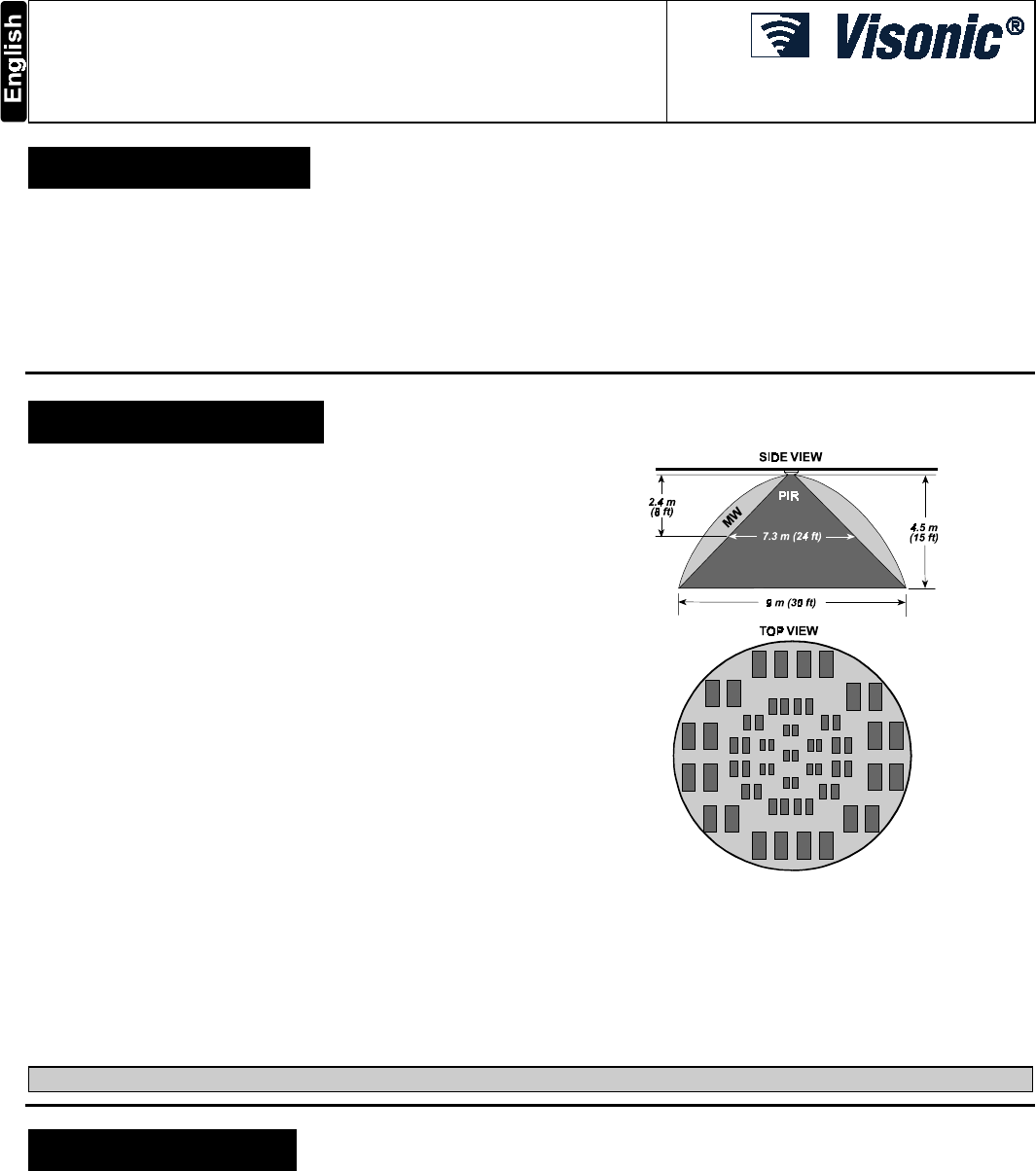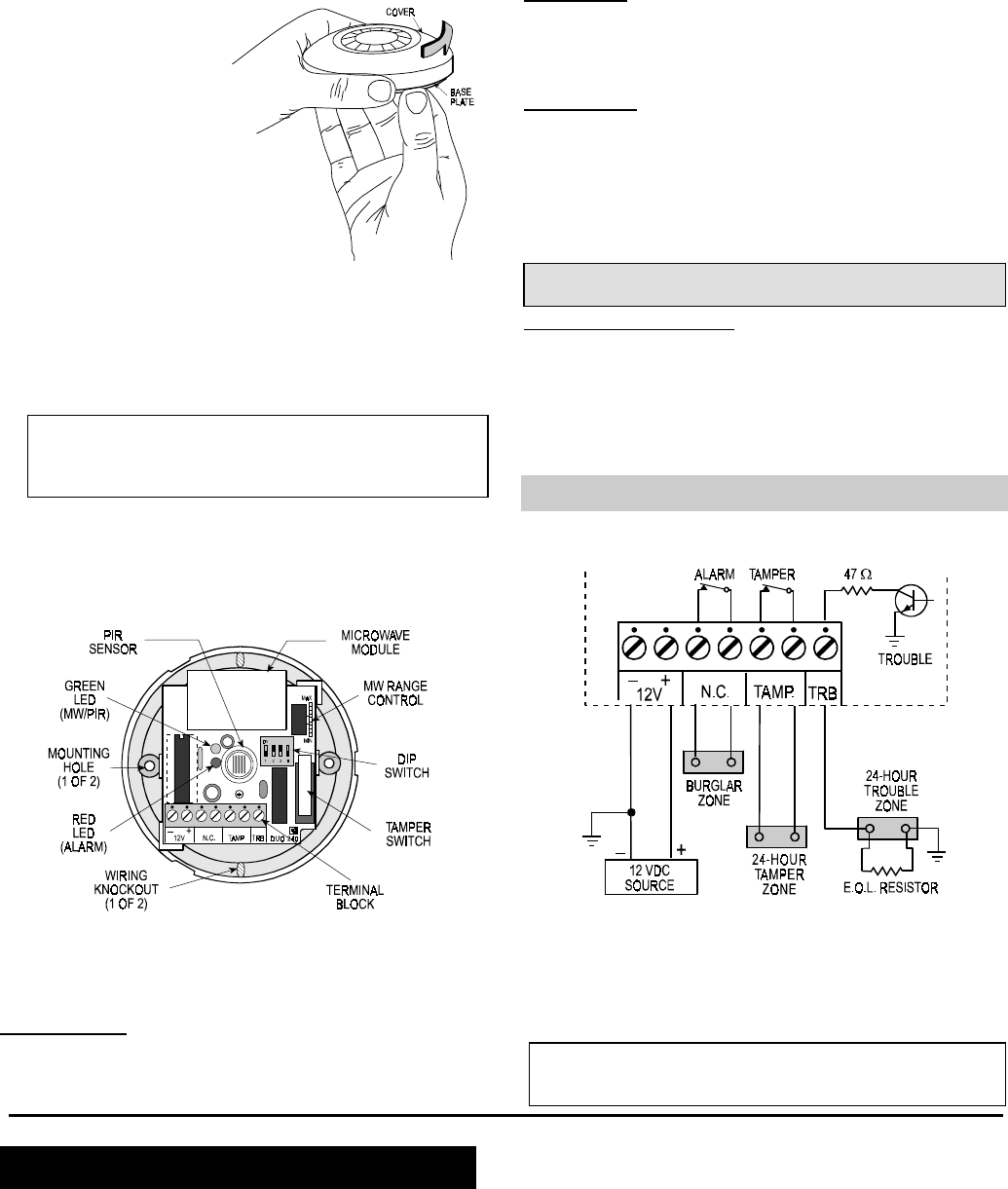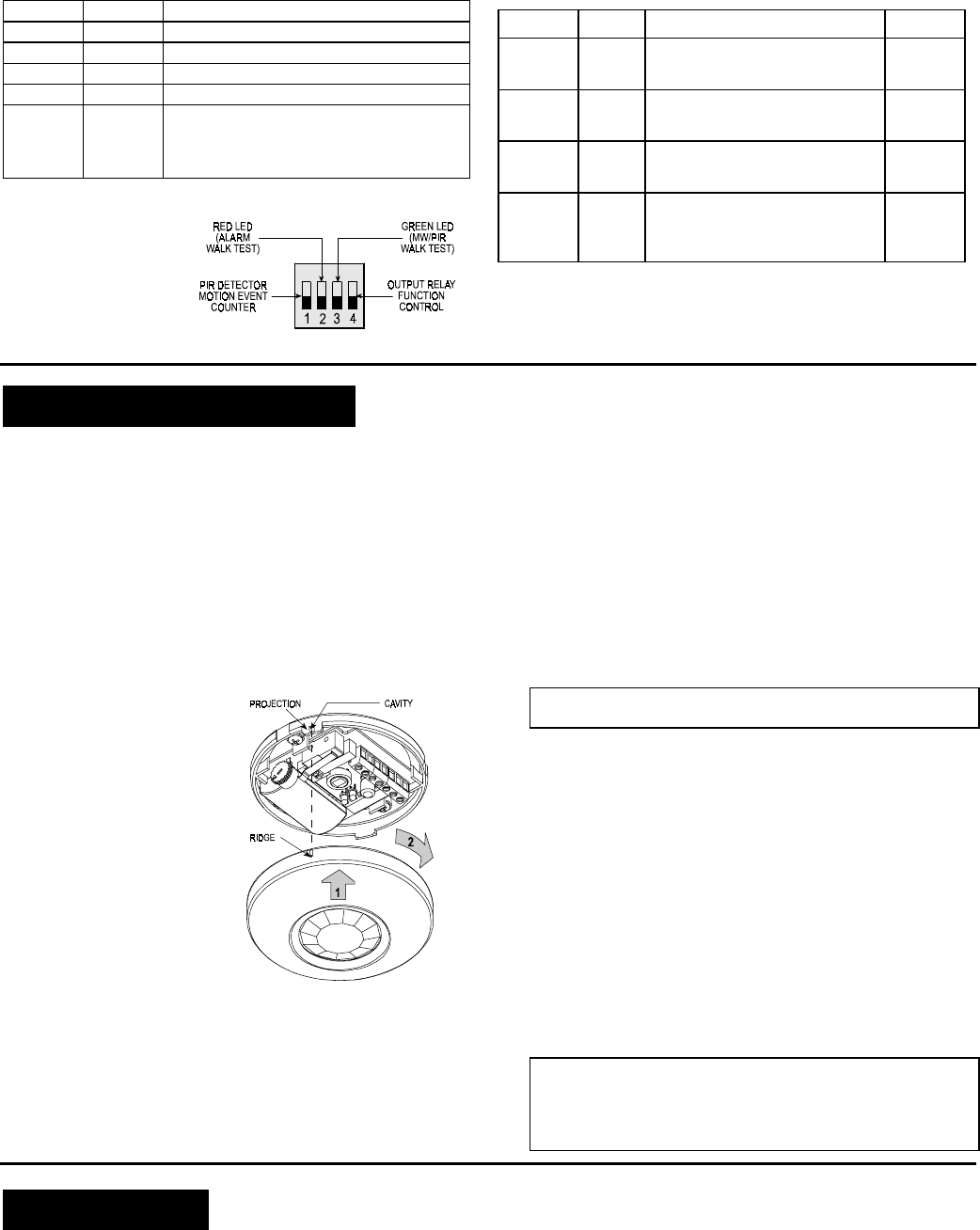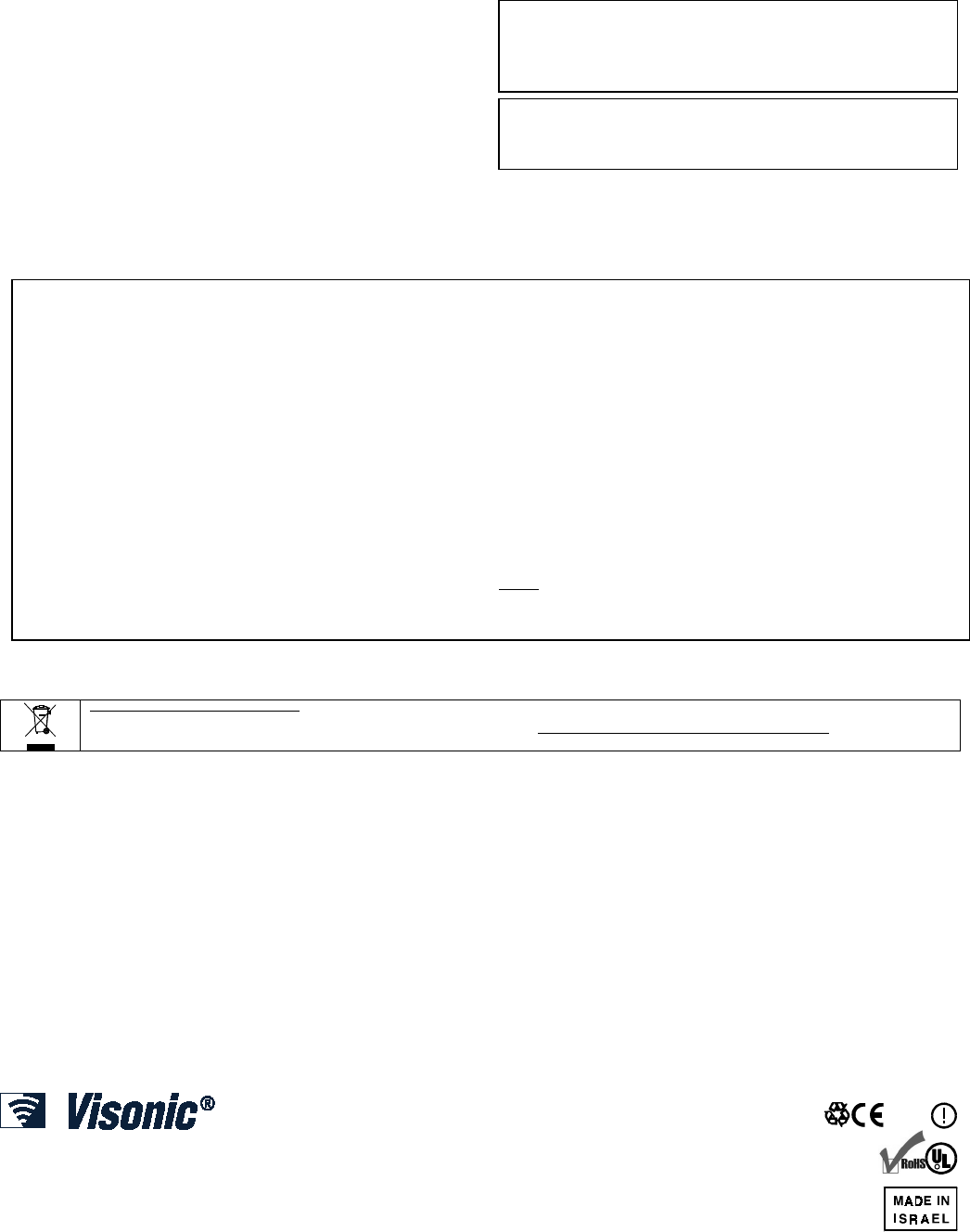Visonic DUO240E CEILING MOUNTED DUEL TECHNOLOGY DETECTOR User Manual 1
Visonic Inc. CEILING MOUNTED DUEL TECHNOLOGY DETECTOR 1
Visonic >
USERS MANUAL

DUO 240
Ceiling-Mount Dual Technology Intrusion Detector
Installation Instructions
1. INTRODUCTION
DUO 240 is a microcomputer-controlled, ceiling-mounted dual-
technology intrusion detector. Its operation is based on two
physical phenomena - the infrared (IR) radiation emitted by the
human body and the Doppler frequency shift caused by a person
moving in a microwave (MW) field. The IR and MW technologies,
when combined in a single detector, complement each other to
assure the most reliable detection and immunity to false alarms.
The superiority of the DUO 240 over other dual detectors has
been achieved by the advent of a True Motion Recognition™
algorithm (patented). This advanced motion analysis method
provides the DUO 240 with the ability to distinguish between the
true motion of a human body and any other disturbances which
invariably cause false alarms.
Another unique feature of the DUO 240 is the MW Motion
Simulator circuit (patents applied for), which simulates the effect
created by a human body moving in the MW field. The simulation
routine is carried out periodically for self-testing, supervision and
assurance that the MW detector operates properly.
2. SPECIFICATIONS
Input Voltage: 9 to 16 VDC
Current Drain: About 30 mA @ 12 VDC
PIR SECTION
Detector: Low noise dual-element pyroelectric sensor
Trip Indication: Green LED flashes for up to 5 seconds
True Motion Event Verification Counter: 1 or 2 events
Detection Pattern: A virtually conical pattern of maximum 9 m
(30 ft) diameter, when installed on a 4.5 m (15 ft) ceiling (Fig. 1).
Mounting on a lower ceiling will reduce the coverage area.
MW SECTION
Oscillator: Microstrip DRO-stabilized type
Frequency: 2.45 GHz
Detection Range: Adjustable from 25% to 100%
Trip Indication: Green LED lights for up to 5 seconds
ALARM, TAMPER & TROUBLE DATA
Alarm Indication: Red LED lights for 2-3 s (both detectors trip)
Relay Contacts: Normally closed, 0.1 A resistive/30 VDC; 18 Ω
resistor in series with contacts
Alarm Duration: 2-3 seconds (red LED lights and output relay
contacts open)
Tamper Contacts: Normally closed, 50 mA resistive/ 30 VDC
Trouble Output: Open-collector, 100 mA max., with 47 Ω resistor
in series
MOUNTING AND PHYSICAL DATA
Maximum Mounting Height: 4.5 m (15 ft)
Dimensions (H x Ø): 24 x 86 mm (3.4 x 0.95 in.)
Weight: 64 g (2 oz)
Color: White
Figure 1. DUO 240 Coverage Pattern
ENVIRONMENTAL CONDITIONS
Operating Temperature: –10°C to 50°C (14°F to 122°F)
Storage Temperature: –20°C to 60°C (–4°F to 140°F)
RFI Protection: Greater than 30 V/m (20 to 1000 MHz)
PATENTS
U.S. Patents 5,237,330 and 5,693,943 (other patents pending)
Compliance with standards: EN 50131-1 Grade 2 Class II
ATTENTION! Detection occurs only in areas in which the MW and PIR patterns overlap.
3.INSTALLATION
3.1 General Guidelines
A few important rules must be observed before selecting a
mounting location.
• Microwave radiation passes through glass and nonmetallic
walls and floors. Be sure to adjust the MW range to the
necessary minimum, to reduce the possibility of interference
from lower floors.
• Large reflecting objects (especially metals) within the
coverage area can distort the microwave detector's coverage
pattern.
• Although the DUO 240 is extremely immune to air turbulence
and RF interference, avoid installation in a room with very
strong air drafts or close to high-power electrical cables. It is
also recommended to avoid aiming the detection pattern at
sources of bright light and/or heat.
• If two DUO 240 units are installed in the same room, they
should be mounted at least 2 m (6 ft) apart.
• Always mount the unit on a firm and stable ceiling and
remember that the height above the floor determines the size
of the circular coverage pattern.
• Do not install the DUO 240 in places where one of the two
detectors alarms constantly or intermittently, due to
environmental interference.
DE1826 1

3.2 Mounting
Select the mounting location
in accordance with the
guidelines in Section 3.1.
Make sure that the expected
intruder's path will cross the
detector's coverage pattern.
DUO 240 units can be
mounted at the maximum
height of 4.5 m (15 ft).
Proceed as follows:
A. Hold the base with one
hand as shown in Fig. 2.
Twist the cover counter-
clockwise with the other
hand until it stops.
Separate the cover from
Figure 2. Separating the Cover
from the Base
the base, and put it in a safe place, to avoid accidental
damage.
B. Press the base against the ceiling in the selected location.
Mark the two points for drilling through the mounting holes
(see Fig. 3).
Note: The mounting holes are accessible without removing
the printed circuit board from the base. Do not drill with the
detector held in place, to avoid contaminating the unit with
dust and drilled fragments.
C. Put the base aside, drill the two holes in the ceiling and insert
masonry anchors if necessary.
D. Punch out at least one wiring knockout (preferably the one
close to the terminal block).
E. Align the unit (including printed circuit board) with the mounting
holes and fasten it firmly to the ceiling with two screws.
Figure 3. Component Layout
3.3 Wiring
Connect wires to the terminal block in the following order (Fig. 4):
Terminal: TAMP (tamper switch)
Connect to: A normally closed 24-hour tamper zone of the
control panel.
Details: Once the cover is removed, the tamper switch opens.
Terminal: NC (alarm relay)
Connect to: Normally closed burglar protection zones of the
control panel.
Details: Upon alarm or power failure, the output relay's normally
closed contacts open.
Terminal: TRB (trouble output)
Connect to: 24-hour trouble zone, parallel to an E.O.L. resistor
(see Figure 4).
Details: The TRB open collector output will be grounded upon
detector malfunction, causing disturbance in the trouble zone of
the associated alarm system.
Alternative: A buzzer or an interface relay (100 mA max.) may
be connected across the TRB output and the 12 V (+) terminals.
In UL installations, the buzzer, control panel or relay to which
the trouble output is connected must be UL-listed.
Terminals: 12 V(+) and (–)
Connect to: A power source within the range of 9 VDC to 16
VDC. Take care not to reverse the polarity.
Details: It is advisable to connect the power source only after all
other connections have been completed and rechecked.
Disconnect the AC mains from the alarm control panel and verify
that the voltage supplied to the detector is above 9 Volts with the
backup battery as the only power source.
IMPORTANT: To comply with CE safety requirements, connect to
CE-approved control panels with current-limited DC output.
Note: Use RTV to seal the base opening(s) to prevent insects
from entering the detector.
Figure 4. Terminal Block Wiring
3.4 The Power-up Process
After connecting the (+) and (–) terminals to the power source,
the DUO 240 starts a 60-second warm-up period, indicated by
alternate flashing of the green and red LEDs.
Caution! If the alternate flashing of the LEDs does not stop
within 60 seconds, a failure has been detected by the self-test
circuitry and the TRB output is activated
4. INDICATORS AND SELECTORS
4.1 LED Indications
The two LEDs (Fig. 3), which are hidden behind the lens when
the cover is installed, are visible through the lens when
illuminated. They are used to signal various alarm and trouble
messages as shown in Table 1 below:
Notes:
1. During walk testing, the first LED to respond is the green one.
It illuminates steadily (MW detection) or flashes (PIR
detection), depending on which detector discovered the
movement first. Upon subsequent discovery of the movement
by the other detector, the green LED will go off and the red
LED will illuminate (alarm).
2. If the green and red LEDs continue to flash beyond the warm-
up period, a malfunction has been diagnosed. Replace the
unit without delay.
2 DE1826

Table 1. Interpreting the States of the LEDs
GREEN RED Significance
Off Off No detection
On Off MW walk-test detection
Flashes Off PIR walk-test detection
Off On Alarm: MW + PIR detection
Flashes Flashes Trouble is being detected by the self
test circuitry, or Initial warm-up
routine (stops 60 seconds after
power up).
4.2 Mode Selector
The DIP switch mode
selector is mounted on
the unit’s PC board
(Fig. 3). It controls four
functions as demons-
trated in Fig. 5 and as
detailed in Table 2.
Figure 5. DIP Switch Mode Selector
Table 2. Mode Selector Switch Functions
Switch State Function Default
SW-1 OFF
ON
One motion event trips the PIR
Two motion events trip the PIR
ON
SW-2 OFF
ON
Alarm walk test is disabled*
Alarm walk test is enabled
ON
SW-3 OFF
ON
MW/PIR walk test is disabled*
MW/PIR walk test is enabled
ON
SW-4 OFF
ON
Output relay opens upon alarm
Output relay opens upon alarm
and when trouble is detected.
OFF
* Setting SW-2 and SW-3 to OFF does not disable the trouble
indication (flash/flash).
5. INITIAL ADJUSTMENT
5.1 Setting the Motion Event Counter
If you wish to set the PIR detector for maximum false alarm
immunity, shift DIP switch No. 1 (SW-1) to ON. In this position,
two consecutive motion events are required to trip the PIR
detector.
For faster catch performance, shift SW-1 to OFF. In this position,
only one motion event is required to trip the PIR detector.
5.2 PIR Walk Test
A. Rotate the MW RANGE control all the way toward MIN.
B. Verify that DIP switch SW-3 is set to ON (the green walk-test
LED is enabled).
C. Mount the front cover in
place: line up the ridge
on the cover with the
cavity in one of the two
projections on the base
circumference (Fig 6). Fit
the cover over the base,
and rotate the cover
clockwise until it stops.
D. Walk into the detector's
field of view at the
expected far edge of the
coverage area. The
green LED should flash
for up to 5 seconds each
time your motion is
detected.
F
igure 6. Remounting the Cover
E. If PIR detection is not obtained at the far edge of the coverage
area, verify that the infrared radiation is not blocked or
diverted by intervening objects such as large lampshades, air
conditioning ducts etc.
Note: If the green LED illuminates steadily, your motion has
been detected by the MW detector and not by the PIR.
5.3 MW Walk Test
A. Remove the front cover.
B. Verify that the MW range control is set to MIN and that DIP
switch SW-3 is set to ON (the green walk-test LED is
enabled). Close cover (see section 5.2 C).
C. Start by moving into the coverage area at the far edge. The
green LED should light steadily for up to 5 seconds each time
your motion is detected.
D. If your motion was not detected at the far edge of the
coverage area, advance the MW RANGE control slightly
toward MAX and try again until your motion is detected
reliably at the far edge.
Caution! The MW detection range must not exceed the far
edge of the desired coverage area.
E. Walk across the coverage area at various ranges and verify
that your motion is consistently detected.
Note: If PIR trips interfere with your test, disable the PIR by
inserting a small piece of cardboard in front of the sensor.
5.4 Alarm Walk Test
A. Set DIP switches SW-2 and SW-3 to ON (both LEDs are
enabled).
B. Temporarily mount the detector's cover in place.
C. Walk across the detector’s field of view in different directions,
at various distances from the detector, and verify proper
detection throughout the entire coverage area (the red LED
will illuminate for 2 to 3 seconds).
D. When done, remove the cover and set DIP switches SW-2
and SW-3 to OFF to prevent unauthorized people from tracing
the coverage pattern.
E. Remount the cover.
Attention! To assure proper function of the detector, the
range and coverage area should be checked at least twice a
year. Furthermore, it is recommended to perform a walk test
at the far end of the coverage pattern to assure an alarm
signal prior to each time the alarm system is armed.
6. WARNINGS
Although this detector is a highly reliable device, it does not
guarantee complete protection against intrusion. Even the most
sophisticated detectors can sometimes be defeated or may fail to
warn because:
A. The detector will not function if the DC power supplied to it is
incorrect or improperly connected.
B. Detection is confined to the area covered by the detection
pattern as adjusted by the installer.
C. A PIR detector does not provide full volumetric coverage of
the protected area. It can only detect motion that disturbs the
sensitive beam array spread within the protected space.
DE1826 3

D. Motion will not be detected by PIRs if it takes place behind
closed doors, floors, walls, ceilings, glass partitions, windows
and shutters.
E. The detection ability of the PIR detector may be reduced by
malicious masking or by spraying various materials on the
optical lens. Mechanical tampering may also damage the
optical system.
F. The PIR detector's performance can decrease as the ambient
temperature within the protected area approaches the range
of 32° - 40°C (90° -105°F).
G. The protection pattern provided by the microwave detector
may be altered by metal objects or foil-covered insulation.
H. Even the most reliable electrical devices, including this
detector, may go wrong because of unexpected failure of
component parts.
The above list includes the most common reasons for failure to
detect intrusion, but it is by no means comprehensive. It is
therefore recommended that the detector and the entire alarm
system be checked weekly, to ensure proper performance.
An alarm system should not be regarded as a substitute for
insurance. Home and property owners or renters should be
prudent enough to continue insuring their lives and property, even
though they are being protected by an alarm system.
This device complies with Part 15 of the FCC Rules and RSS-210 of
Industry and Science Canada. Operation is subject to the following
two conditions: (1) This device may not cause harmful interference,
and (2) this device must accept any interference received, including
interference that may cause undesired operation.
This device complies with the essential requirements and provisions
of Directive 1999/5/EC of the European Parliament and of the
Council of 9 March 1999 on radio and telecommunications terminal
equipment.
Note: The manufacturer is not responsible for any radio or TV
interference caused by unauthorized modifications to this
equipment. Such modifications could void the user’s authority to
operate the equipment.
WARRANTY
Visonic Limited (the “Manufacturer") warrants this product only (the "Product") to the original purchaser only (the
“Purchaser”) against defective workmanship and materials under normal use of the Product for a period of twelve
(12) months from the date of shipment by the Manufacturer.
This Warranty is absolutely conditional upon the Product having been properly installed, maintained and operated
under conditions of normal use in accordance with the Manufacturers recommended installation and operation
instructions. Products which have become defective for any other reason, according to the Manufacturers
discretion, such as improper installation, failure to follow recommended installation and operational instructions,
neglect, willful damage, misuse or vandalism, accidental damage, alteration or tampering, or repair by anyone
other than the manufacturer, are not covered by this Warranty.
The Manufacturer does not represent that this Product may not be compromised and/or circumvented or that the
Product will prevent any death and/or personal injury and/or damage to property resulting from burglary, robbery,
fire or otherwise, or that the Product will in all cases provide adequate warning or protection. The Product,
properly installed and maintained, only reduces the risk of such events without warning and it is not a guarantee
or insurance that such events will not occur.
THIS WARRANTY IS EXCLUSIVE AND EXPRESSLY IN LIEU OF ALL OTHER WARRANTIES,
OBLIGATIONS OR LIABILITIES, WHETHER WRITTEN, ORAL, EXPRESS OR IMPLIED, INCLUDING ANY
WARRANTY OF MERCHANTABILITY OR FITNESS FOR A PARTICULAR PURPOSE, OR OTHERWISE. IN
NO CASE SHALL THE MANUFACTURER BE LIABLE TO ANYONE FOR ANY CONSEQUENTIAL OR
INCIDENTAL DAMAGES FOR BREACH OF THIS WARRANTY OR ANY OTHER WARRANTIES
WHATSOEVER, AS AFORESAID.
THE MANUFACTURER SHALL IN NO EVENT BE LIABLE FOR ANY SPECIAL, INDIRECT, INCIDENTAL,
CONSEQUENTIAL OR PUNITIVE DAMAGES OR FOR LOSS, DAMAGE, OR EXPENSE, INCLUDING LOSS
OF USE, PROFITS, REVENUE, OR GOODWILL, DIRECTLY OR INDIRECTLY ARISING FROM
PURCHASER’S USE OR INABILITY TO USE THE PRODUCT, OR FOR LOSS OR DESTRUCTION OF
OTHER PROPERTY OR FROM ANY OTHER CAUSE, EVEN IF MANUFACTURER HAS BEEN ADVISED OF
THE POSSIBILITY OF SUCH DAMAGE.
THE MANUFACTURER SHALL HAVE NO LIABILITY FOR ANY DEATH, PERSONAL AND/OR BODILY
INJURY AND/OR DAMAGE TO PROPERTY OR OTHER LOSS WHETHER DIRECT, INDIRECT, INCIDENTAL,
CONSEQUENTIAL OR OTHERWISE, BASED ON A CLAIM THAT THE PRODUCT FAILED TO FUNCTION.
However, if the Manufacturer is held liable, whether directly or indirectly, for any loss or damage arising under this
limited warranty, THE MANUFACTURER'S MAXIMUM LIABILITY (IF ANY) SHALL NOT IN ANY CASE
EXCEED THE PURCHASE PRICE OF THE PRODUCT, which shall be fixed as liquidated damages and not as a
penalty, and shall be the complete and exclusive remedy against the Manufacturer.
When accepting the delivery of the Product, the Purchaser agrees to the said conditions of sale and warranty and
he recognizes having been informed of.
Some jurisdictions do not allow the exclusion or limitation of incidental or consequential damages, so these
limitations may not apply under certain circumstances.
The Manufacturer shall be under no liability whatsoever arising out of the corruption and/or malfunctioning of any
telecommunication or electronic equipment or any programs.
The Manufacturers obligations under this Warranty are limited solely to repair and/or replace at the
Manufacturer’s discretion any Product or part thereof that may prove defective. Any repair and/or replacement
shall not extend the original Warranty period. The Manufacturer shall not be responsible for dismantling and/or
reinstallation costs. To exercise this Warranty the Product must be returned to the Manufacturer freight pre-paid
and insured. All freight and insurance costs are the responsibility of the Purchaser and are not included in this
Warranty.
This warranty shall not be modified, varied or extended, and the Manufacturer does not authorize any person to
act on its behalf in the modification, variation or extension of this warranty. This warranty shall apply to the
Product only. All products, accessories or attachments of others used in conjunction with the Product, including
batteries, shall be covered solely by their own warranty, if any. The Manufacturer shall not be liable for any
damage or loss whatsoever, whether directly, indirectly, incidentally, consequentially or otherwise, caused by the
malfunction of the Product due to products, accessories, or attachments of others, including batteries, used in
conjunction with the Products. This Warranty is exclusive to the original Purchaser and is not assignable.
This Warranty is in addition to and does not affect your legal rights. Any provision in this warranty which is
contrary to the Law in the state or country were the Product is supplied shall not apply.
Warning:The user must follow the Manufacturer’s installation and operational instructions including testing the
Product and its whole system at least once a week and to take all necessary precautions for his/her safety and
the protection of his/her property.
1/08
W.E.E.E. Product Recycling Declaration
For information regarding the recycling of this product you must contact the company from which you orignially purchased it. If you are discarding this product and not
returning it for repair then you must ensure that it is returned as identified by your supplier. This product is not to be thrown away with everyday waste.
Directive 2002/96/EC Waste Electrical and Electronic Equipment.
VISONIC LTD. (ISRAEL): P.O.B 22020 TEL-AVIV 61220 ISRAEL. PHONE: (972-3) 645-6789, FAX: (972-3) 645-6788
VISONIC INC. (U.S.A.): 65 WEST DUDLEY TOWN ROAD, BLOOMFIELD CT. 06002-1376. PHONE: (860) 243-0833, (800) 223-0020 FAX: (860) 242-8094
VISONIC LTD. (UK): FRASER ROAD, PRIORY BUSINESS PARK, BEDFORD MK44 3WH. PHONE: (0870) 7300800 FAX: (0870) 7300801
INTERNET: www.visonic.com
VISONIC LTD. 2008 DUO 240 DE1826- (PREPARATION FOR REV. 5 05/08)
0122
R
4 DE1826